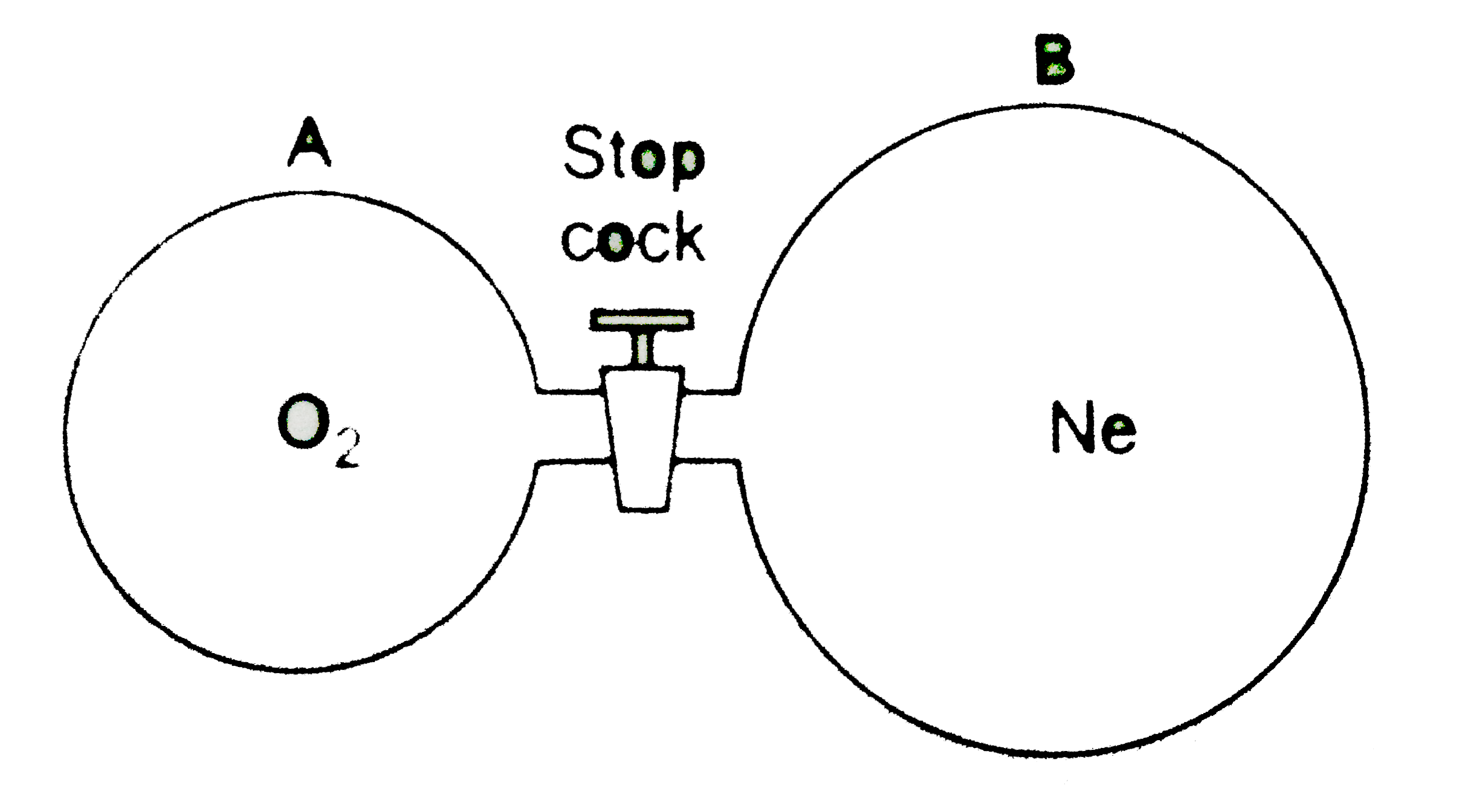Consider the adjacent diagram. Initially, flask A contained oxygen gas at 27∘C and 950mm of Hg, and flask B contained neon gas at 27∘C and 900mm. Finally, two flask were joined by means of a narrow tube of negligible volume equipped with a stopcock and gases were allowed to mixup freely. The final pressure in the combined system was found to be 910mm of Hg.

What is the correct relationship between volumes of the two flasks?
VB=2VA
VB=4VA
VB=5VA
VB=5.5VA
Given, Initial condition
PA=950mm, VA=?, TA=300K
PB=900mm, VB=?, TA=300K
∴n→tal=PVRT=950×VAR×300+900×VBR×300
Final condition
PA=910, VA=?TA=300
PB=910, VB=?TB=300
∴n→tal=PVRT=910×VAR×300+900×VBR×300
Since n→tal= constant
∴950×VAR×300+900×VBR×300=910×VAR×300+910×VBR×300
Therefore, VB=4VA
Topper's Solved these Questions
- STATES OF MATTERBOOK - CENGAGE CHEMISTRYCHAPTER - STATES OF MATTEREXERCISE - Exercises (Multiple Correcttype)
32 Videos
- STATES OF MATTERBOOK - CENGAGE CHEMISTRYCHAPTER - STATES OF MATTEREXERCISE - Exercises (Single Correct)
85 Videos
- STATES OF MATTERBOOK - CENGAGE CHEMISTRYCHAPTER - STATES OF MATTEREXERCISE - Exercises
21 Videos
- SOME BASIC CONCEPTS AND MOLE CONCEPTBOOK - CENGAGE CHEMISTRYCHAPTER - SOME BASIC CONCEPTS AND MOLE CONCEPTEXERCISE - Archives Subjective
11 Videos
- STOICHIOMETRYBOOK - CENGAGE CHEMISTRYCHAPTER - STOICHIOMETRYEXERCISE - Archives Subjective
33 Videos
Similar Questions
Initially bulb "a" contained oxygen gas at 27∘C and 950 mm of Hg and bulb "B" contained neon gas at 27∘C and 900 mm of Hg. These bulbs are connected by a narrow tube of negligible volume equipped with a stopcock and gases were allowed to mix-up freely. The pressure obtained in the combined system was found to be 910 mm of Hg.

If volume of bulb B was measured to be 10 L, then find the volume of oxygen gas present initially in bulb "A" .
View SolutionWhat is the volume occupied by 30 g of neon gas at 67∘C and 750 mm of Hg?
View Solution
Knowledge Check
Consider the adjacent diagram. Initially, flask A contained oxygen gas at 27∘C and 950mm of Hg, and flask B contained neon gas at 27∘C and 900mm. Finally, two flask were joined by means of a narrow tube of negligible volume equipped with a stopcock and gases were allowed to mixup freely. The final pressure in the combined system was found to be 910mm of Hg.

Which of the following statements concerning oxygen and neon gas is true in the begining, when the stopcock was just opened?AO2 moved at faster rate toward flask B.BNe moved at faster rate towards flask A.CBoth O2 and Ne gases moves at equal rate.DInsufficient information to compare the rate of effusion.Consider the adjacent diagram. Initially, flask A contained oxygen gas at 27∘C and 950mm of Hg, and flask B contained neon gas at 27∘C and 900mm. Finally, two flask were joined by means of a narrow tube of negligible volume equipped with a stopcock and gases were allowed to mixup freely. The final pressure in the combined system was found to be 910mm of Hg.

If flask B were heated to 127∘C, maintaining flask A at constant temperature of 27∘C, final pressure (in mmHg) in the combined system would have beenA1007B1250C1137.5D1990At NTP the volume of a gas is 40 mL . If pressure is increased to 800 mm of Hg at the same temperature what will be the volume of the gas ?
A38 mLB22400 mLC240 mLD431 mL
Calculate the volume occupied by 7 g of nitrogen gas at 27∘C and 750 mm Hg pressure
View SolutionCalculate RMS velocity of ethane at 27∘ C and 720 mm of Hg pressure.
View Solution2gm of O2 at 27∘C and 76mm of Hg pressure has volume
View Solution273 mL of a gas at STP was taken to 27∘C and 600 mm pressure. The final volume of the gas would be :
View Solution380 mL of a gas at 27∘C , 800 mm of Hg weights 0.455 g . The mol., wt. of gas is :
View Solution
